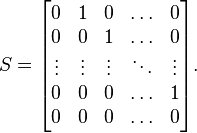Nilpotent matrix
In linear algebra, a nilpotent matrix is a square matrix N such that
for some positive integer k. The smallest such k is sometimes called the degree of N.
More generally, a nilpotent transformation is a linear transformation L of a vector space such that Lk = 0 for some positive integer k (and thus, Lj = 0 for all j ≥ k). Both of these concepts are special cases of a more general concept of nilpotence that applies to elements of rings.
Examples
The matrix
is nilpotent, since M2 = 0. More generally, any triangular matrix with 0s along the main diagonal is nilpotent. For example, the matrix
is nilpotent, with
Though the examples above have a large number of zero entries, a typical nilpotent matrix does not. For example, the matrix
squares to zero, though the matrix has no zero entries.
Characterization
For an n × n square matrix N with real (or complex) entries, the following are equivalent:
- N is nilpotent.
- The minimal polynomial for N is λk for some positive integer k ≤ n.
- The characteristic polynomial for N is λn.
- The only eigenvalue for N is 0.
- tr(Nk) = 0 for all k > 0.
The last theorem holds true for matrices over any field of characteristic 0 or sufficiently large characteristic. (cf. Newton's identities)
This theorem has several consequences, including:
- The degree of an n × n nilpotent matrix is always less than or equal to n. For example, every 2 × 2 nilpotent matrix squares to zero.
- The determinant and trace of a nilpotent matrix are always zero.
- The only nilpotent diagonalizable matrix is the zero matrix.
Classification
Consider the n × n shift matrix:
This matrix has 1s along the superdiagonal and 0s everywhere else. As a linear transformation, the shift matrix “shifts” the components of a vector one slot to the left:
This matrix is nilpotent with degree n, and is the “canonical” nilpotent matrix.
Specifically, if N is any nilpotent matrix, then N is similar to a block diagonal matrix of the form
where each of the blocks S1, S2, ..., Sr is a shift matrix (possibly of different sizes). This theorem is a special case of the Jordan canonical form for matrices.
For example, any nonzero 2 × 2 nilpotent matrix is similar to the matrix
That is, if N is any nonzero 2 × 2 nilpotent matrix, then there exists a basis b1, b2 such that Nb1 = 0 and Nb2 = b1.
This classification theorem holds for matrices over any field. (It is not necessary for the field to be algebraically closed.)
Flag of subspaces
A nilpotent transformation L on Rn naturally determines a flag of subspaces
and a signature
The signature characterizes L up to an invertible linear transformation. Furthermore, it satisfies the inequalities
Conversely, any sequence of natural numbers satisfying these inequalities is the signature of a nilpotent transformation.
Additional properties
- If N is nilpotent, then I + N is invertible, where I is the n × n identity matrix. The inverse is given by
- where only finitely many terms of this sum are nonzero.
- If N is nilpotent, then
- where I denotes the n × n identity matrix. Conversely, if A is a matrix and
- for all values of t, then A is nilpotent. In fact, since
 is a polynomial of degree
is a polynomial of degree  , it suffices to have this hold for
, it suffices to have this hold for  distinct values of
distinct values of  .
.
- Every singular matrix can be written as a product of nilpotent matrices.[1]
Generalizations
A linear operator T is locally nilpotent if for every vector v, there exists a k such that
For operators on a finite-dimensional vector space, local nilpotence is equivalent to nilpotence.
References
- ↑ R. Sullivan, Products of nilpotent matrices, Linear and Multilinear Algebra, Vol. 56, No. 3















